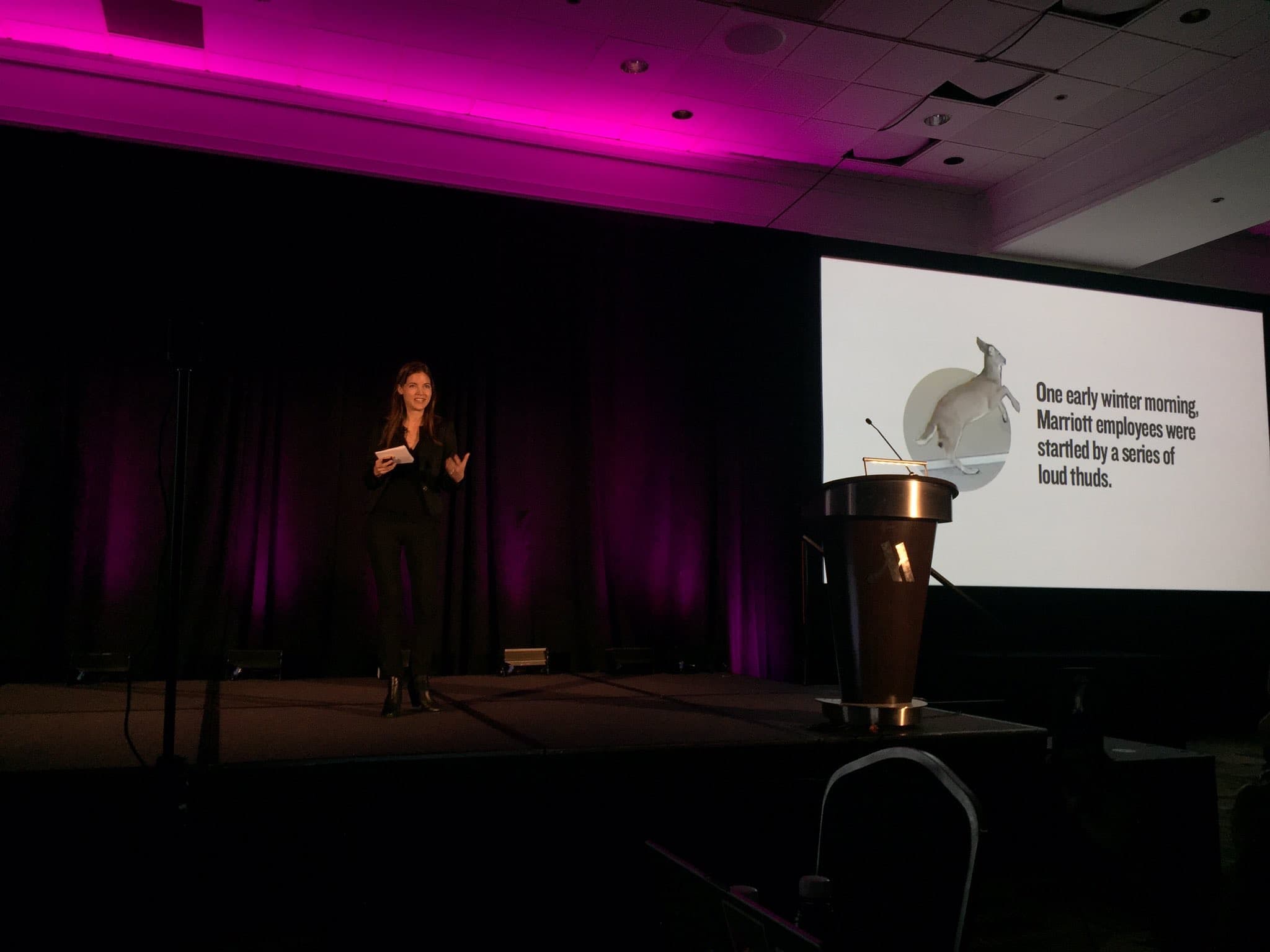“Your vibe attracts your tribe!” – Kathryn Minshew
An amazing keynote presentation delivered by Kathryn Minshew at SourceCon, founder of The Muse “Oh Look a Purple Squirrel! Break Outside of the Box and Beyond Traditional Sourcing.” I have the pleasure of sharing today with you Minshew’s insights and key takeaways from her presentation. The main focus is how employers can use brand awareness to think outside of the traditional means of sourcing.
Minshew starts off with a brilliant example of how Marriott uses branding. One winter morning in January, early bird employees showed up at Bethesda Marriott. They began hearing thumps coming from their front entrance. When they went to see what was making those loud thumps, a very large deer was trying to get through the revolving door. Marriott took this and turned into an employee branding message by putting together a couple of clips of the security team helping to get the deer out of the doorway and their branded message was “there is an easier way to get your foot in the door at Marriott,” said Minshew.

Key Takeaway Point One. Minshew shared examples and lessons that she has learned over the last five years regarding employer branding. The employer brand is a promise to a customer about what to expect from the company. What are current employees buying into and how can they relate to the company in which they work. It is important to understand what a branding message does for an employer, as well as what it does not do for the employer. There are three basic components to a branding message, Minshew explains. 1) Sets you apart from the crowd. 2) Humanizing company. 3) Gets the right candidates to care.
Key Takeaway Point Two. The next key topic discusses how an employer can strengthen their brand. It begins with creating a story that resonates with your employees. How do you know what your employees are saying? Minshew points out a good example of how an employee’s perception can be skewed. Minshew discusses her experience of when she actually was interviewing for a senior position before she started The Muse. Very early in the sourcing process, they listened to what was looking for and then they told her that is exactly what the job was. Finally, when she got through the interviews and made it to the CEO and employees within the group, she heard a very different job described than what she had expected based on her early conversations. At that point, she withdrew from consideration. Strengthening employee brand by way of employees involves choosing star employees and speaks to them about what attracts them, why they joined the company, and where they can improve.
Very early in the sourcing process, they listened to what she was looking for and then they told her that is exactly what the job was. Finally, when she got through the interviews and made it to the CEO and employees within the group, she heard a very different job described than what she had expected based on her early conversations. At that point, she withdrew from consideration. Strengthening employee brand by way of employees involves choosing star employees and speaking to them about what attracts them, why they joined the company, and where they can improve.
Key Takeaway Point Three. How do you use this information to make a stronger employer brand? Information gathered is being communicated through all different channels, a career website, social channels, phone calls, in-person meetings training, executive leadership speaking engagements. All of this is creating brand awareness.
Key Point Takeaway Point Four. The smartest candidates are flipping the table on employers and wanting to know how they will fit into the company. As a sourcer or recruiter, proactively answer this question even if the candidate doesn’t ask it. You should create concrete stories that tell the candidate what they are looking for. For example, if someone is interested in management style, express stories of management experiences. An interesting concept that Minshew and her team put together is something called “Things That Suck” (TTS). Sitting down with leadership to discuss things within the organization that needs improvement. I think every company should follow suit!
Key Takeaway Point Five. Minshew recommends creating content to get in front of people that are following the company, as well as those that would not have ever considered the company. This content must be authentic to have an impact. It should have core themes that reappear, although the subject may be different.
Key Takeaway Point Six. Create video and written content of your best employees and share their enthusiasm. There are very few things that are more powerful than putting a candidate in a room with someone that is extremely passionate about their job. Make sure to keep the videos and the content short and valuable.
In summary, employers should consider thinking behind the jargon and making content feel humanlike Differentiate content for each platform. Finally, content is a long-term strategy, it is a relationship you are developing with people. Make it personal.
